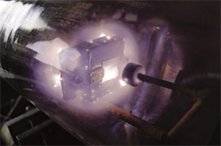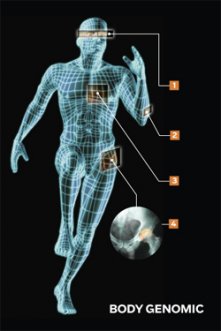In medicine's DNA age, doctors will make pre-emptive, targeted strikes on disease.
In one way, medicine hasn't changed much over the millennia: Doctors still wait for patients to feel sick before beginning treatment of an illness. Genomics promises to change that. By analyzing an individual's genetic makeup, physicians will be able to intervene early − and more precisely. "Generic treatments for certain diseases will be a thing of the past," says Elias Zerhouni, director of the National Institutes of Health. A malady can look the same in two patients, but be caused by a different series of physiological missteps, he explains. "Treatments will be tailored to your particular genomic background."

"NANO" IS THE NEW "CYBER." Attach the prefix to any word and it sounds like the future. Nano-enthusiasts predict a boggling array of micromanufacturers (such as the above plasma chamber for growing nanotubes). An experiment at Israel's Weizmann Institute of Science last spring hinted at nanotech's most compelling use: medicine. Scientists created nano-size computers, says research team leader Ehud Shapiro, that "sense and diagnose molecular symptoms for two types of cancer and release a drug molecule upon diagnosis." The experiment took place in a test tube, but the goal is to send the nanocomputers coursing through the blood to hunt down harmful cells.
Will It Happen? Yes: Stem Cell Cures
While embryonic stem cell research is controversial, little stands in the way of treatments based on the pluripotential stem cells found in bone marrow. One day, they'll help regenerate not only bone and cartilage, but also damaged heart muscle.
Not So Fast: Human Cloning
Dolly the cloned sheep made headlines at birth − and again when, riddled with disease, she was euthanized at an early age. Fewer than 10 percent of cloned embryos survive, and most cloned animals die young, many of gross anatomical abnormalities or cancer. There have been claims of human cloning. Given the technique's record, let's hope they're not true.
DNA COMPUTERS
The smallest computers in the world aren't built, they're grown. A drop of water can hold a trillion strands of DNA, each carrying encoded data just like the rows of 0s and 1s in a silicon computer. A few years ago scientists actually solved a tough mathematical puzzle (dubbed the "traveling salesman" problem) using DNA. Researchers, including Weizmann's Shapiro, now say that DNA computing may find its destiny in medicine, as the basis for blood-borne computers.

1−EYE SCANS
Lasers will help analyze ocular tissue and fluids to detect chemical changes indicating illnesses such as diabetes. The technique, part of routine checkups, will reveal problems months earlier than blood tests once did.
2−SAFE TREATMENTS
Diagnosis of, say, skin cancer will flow from microbiopsies and analysis of a lesion's genetic material. Options may then include designer viruses and nanoparticles that won't harm healthy cells.
3−CARDIAC INTERVENTION
Instead of relying on broad-stroke heart drugs, doctors will target the precise metabolic pathways−which vary among patients−that can lead to blood vessel inflammation and high cholesterol.
4−REBORN JOINTS
Plastic and steel hip and knee replacements will be supplanted by autologous (self-to-self) tissue transplants.
